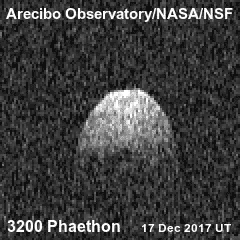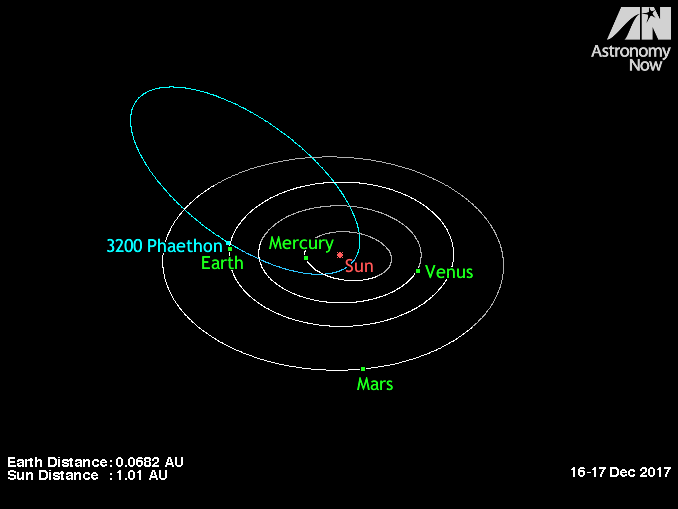Mysterious rock-comet 3200 Phaethon
By Deborah Byrd in Astronomy Essentials | Space | December 17, 20173200 Phaethon – parent object of the Geminid meteors – is an interesting and mysterious object. It was one of the 1st known bodies in space that blurred the distinction between asteroids and comets.

Artist’s concept of what asteroid 3200 Phaethon might look like close up. Notice its blue color and tail of dust. Image via Heather Roper/UANews.
The 2018 Geminid meteor shower peaks this week (best morning likely December 14; try December 13, too). This annual shower is always reliable, but was extra special last year because its parent object – a mysterious, blue rock-comet known as 3200 Phaethon – was nearby. When a parent object is nearby, a meteor shower can be extra rich.
So it was with the Geminids last year (see photos).
This year? 3200 Phaethon is far from Earth, but it’s no less an object of speculation and interest. At a meeting of the Division of Planetary Sciences in Knoxville, Tennessee, earlier this fall, professional astronomers waxed enthusiastic about their studies of 3200 Phaethon in 2017, when it was nearby. They commented that this unusual object was even more enigmatic than they’d previously thought.
What’s so odd about 3200 Phaethon? Let’s start with its blue color. Most asteroids are dull grey to red, depending on the type of material on their surface. Blue asteroids are known, but make up only a fraction of all known asteroids. And Phaethon isn’t just blue. It’s one of the bluest of similarly-colored asteroids (or comets) in the solar system.
Here’s another odd feature of 3200 Phaethon. While comets tend to have more elliptical orbits, asteroid orbits are more circular. 3200 Phaethon’s orbit – which is now exceedingly well known – is highly elongated, reminiscent of some comets. Its orbit crosses the orbits of Mars, Earth, Venus and Mercury.
EarthSky lunar calendars are cool! They make great gifts. Order now. Going fast!

Orbital path of 3200 Phaethon, via SkyandTelescope.com. The 2017 encounter was the closest this object will come to Earth until 2093.
Plus its orbit brings 3200 Phaethon closer to the sun than any other named asteroid (though some smaller, unnamed asteroids come even closer). At its closest point, Phaethon is only 13 million miles (20.9 million km) from the sun. That’s less than half of Mercury’s closest distance. Its name honors this object’s relationship to the sun. In Greek mythology, Phaethon was the son of the sun god Helios.
3200 Phaethon’s orbit carries it so close to the sun that its surface heats up to about 1,500 degrees Fahrenheit (800 degrees C). That’s hot enough to melt aluminum.
When closest to the sun, 3200 Phaethon releases a tiny dust tail; that’s right, it’s a dust tail for an asteroid, one of only two known so far in our solar system. Scientists have said it’s possible the sun’s heat causes fractures, in much the same way a dry riverbed cracks in the afternoon heat.
Comets are known for their tails. 3200 Phaethon’s dust tail is one of the features of this object that blurs the line traditionally thought to set comets and asteroids apart.

This closeup image of 3200 Phaethon by NASA’s STEREO A spacecraft in 2017 shows a tail extending faintly toward lower left. Image via NASA/SkyandTelescope.com.
3200 Phaethon was the first asteroid to be discovered via spacecraft on October 11, 1983. Astronomers Simon F. Green and John K. Davies noticed it while searching Infrared Astronomical Satellite data for moving objects. Charles T. Kowal confirmed it optically and said it was asteroid-like in appearance. The object received the provisional designation 1983 TB. Two years later, in 1985, using the convention for naming asteroids, astronomers assigned it its asteroid number and name: 3200 Phaethon.
Before 3200 Phaethon, scientists linked all known meteor showers to active comets and not asteroids.
Thus 3200 Phaethon surprised them from the beginning, because – while it looked like an asteroid – it appeared to be the source of the annual Geminid meteor shower. Astronomers began calling 3200 Phaethon a comet-asteroid hybrid, an asteroid that behaves like a comet. Later, they began using the term rock-comet.

Radar images of 3200 Phaethon generated by astronomers at the Arecibo Observatory on December 17, 2017. Image via Wikipedia.
At the 2018 DPS meeting, astronomer Teddy Kareta of the University of Arizona’s Lunar and Planetary Laboratory reported on his 2017 studies of 3200 Phaethon. He said:
Kareta and his team analyzed data about 3200 Phaethon obtained in 2017 from NASA’s Infrared Telescope Facility in Hawaii and the Tillinghast telescope in Arizona. These astronomers think Phaethon might be related to or have broken off from 2 Pallas, a large blue asteroid located farther out in the solar system. Karate said:[At first], the assumption was that Phaethon probably was a dead, burnt-out comet, but comets are typically red in color, and not blue. So, even though Phaethon’s highly eccentric orbit should scream ‘dead comet,’ it’s hard to say whether Phaethon is more like an asteroid or more like a dead comet.
The team also observed that Phaethon’s blue color is the same on all parts of its surface, which they say indicates it has been cooked evenly by the sun in the recent past.Interestingly, we found Phaethon to be even darker than had been previously observed, about half as reflective as Pallas. This makes it more difficult to say how Phaethon and Pallas are related.

The composition of 3200 Phaethon resembles that of asteroid 2 Pallas. Both are dark, B-type asteroids composed of materials that have been modified by water. The 1st in this series of Hubble images of 3200 Phaethon in 2017 is marked with the asteroid’s spin axis (top) and south pole. Image via B. E. Schmidt et. al/NASA/ESA/SkyandTelescope.com.
3200 Phaethon is classified as a potentially hazardous asteroid, which doesn’t mean it’s a threat to Earth. It just means two things. First, 3200 Phaethon is big – about 3 miles (5 km) wide – big enough to cause significant regional damage if it were to strike Earth.
Second, it’s known to make periodic close approaches to Earth.
The 2017 “close approach” brought this object to about 26 times the moon’s distance. Astronomers know of no upcoming strike by this object in this foreseeable future.
Both amateur and professional astronomers watched 3200 Phaethon as carefully as they could in 2017. For example, Northolt Branch Observatories in London, England, created the animation below from images it captured in 2017.
Steven Bellavia also produced a video of 3200 Phaethon in 2017 – below. He commented then that he’d endured cloudy weather and sub-freezing temperatures in order to capture the images. “My fingers still hurt!” he wrote.
https://youtu.be/1K6XJZX92bQ
Mike Olason in Denver, Colorado captured 3200 Phaethon on December 4, 2017:

Image via Mike Olason.
The 2017 encounter was the closest this object will come to Earth until 2093.

3200 Phaethon swept close to Earth – jus 0.069 astronomical units (6.4 million miles, 10.3 million km, 26 lunar-distances) on December 16, 2017 at 23 UTC. Image via Osamu Ajiki (AstroArts)/ Ron Baalke (JPL)/Ade Ashford (AN)/AstronomyNow.
Bottom line: 3200 Phaethon is a mysterious rock-comet and the source of the Geminid meteor shower.
Thanks to: https://earthsky.org






 Sat Mar 23, 2024 11:33 pm by globalturbo
Sat Mar 23, 2024 11:33 pm by globalturbo

